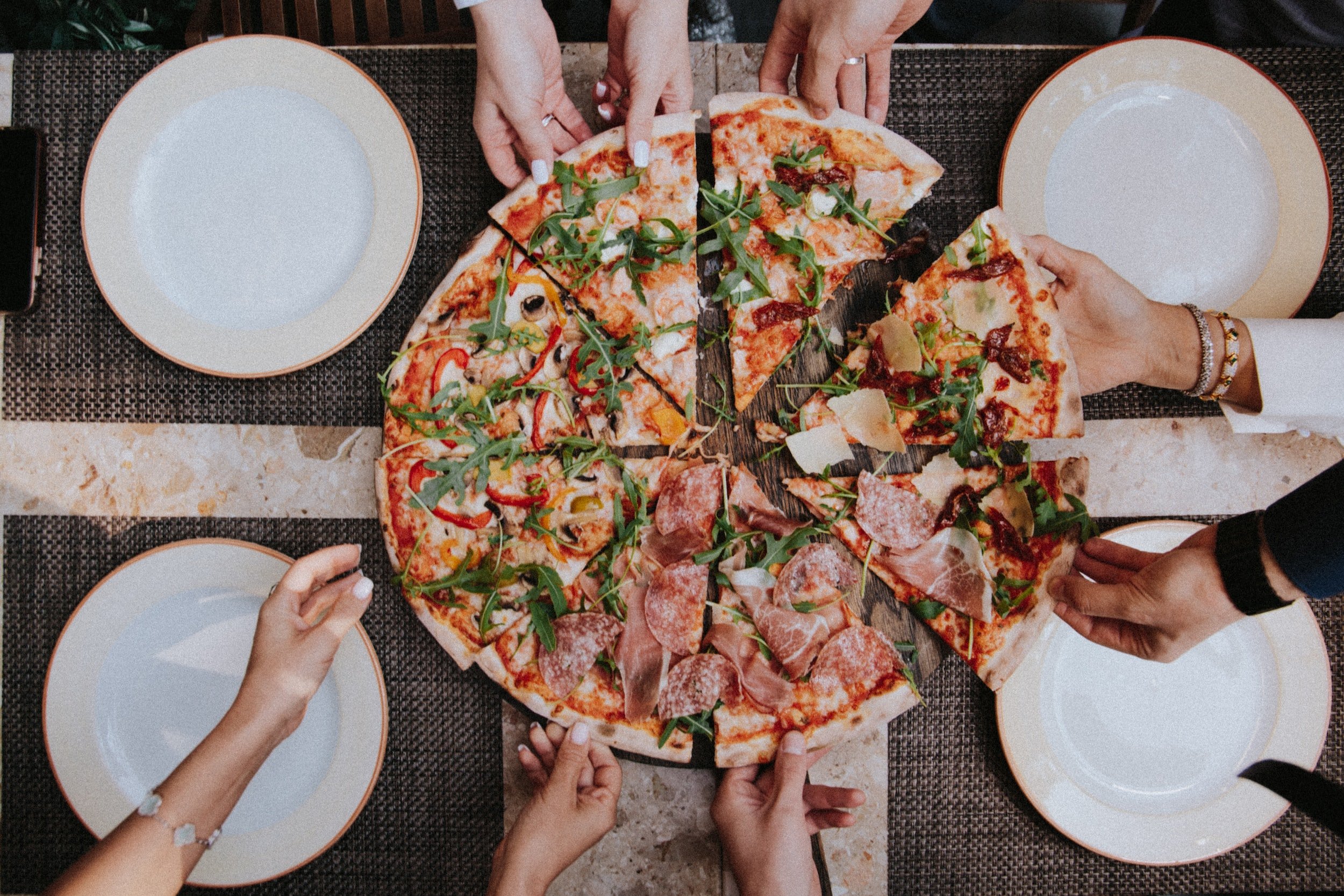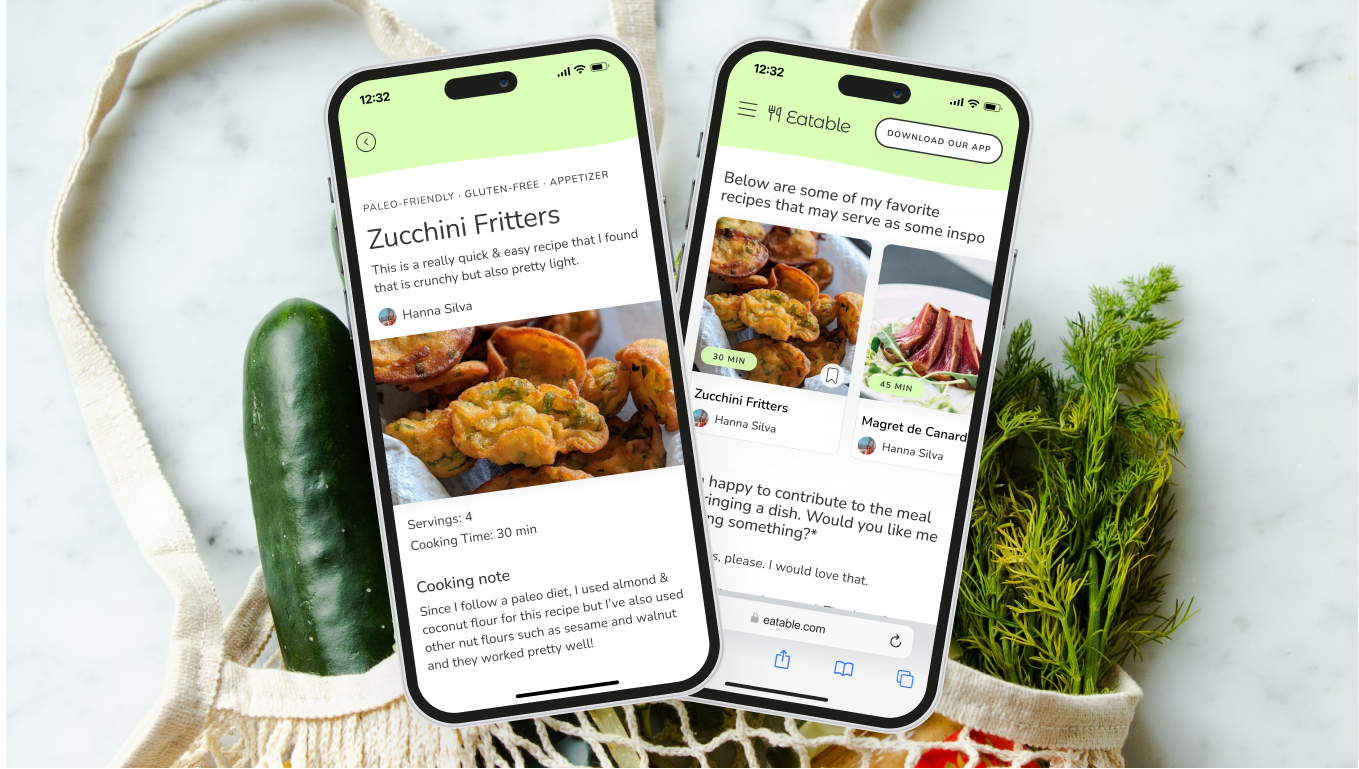
Bridging the communication gap between guests with dietary needs & their hosts
Overviewthe basics
what
Eatable is a health & wellness app that allows guests with dietary needs to seamlessly communicate their necessities to hosts so both can enjoy guilt-free meals together
who
I completed the end-to-end design process as part of a student project
when
March 2023
Initial Problem Investigatedhow Eatable began
Food has the power to bring people together. However, people with dietary restrictions may find it challenging to socialize over meals.
Those who have food restrictions, such as allergies, intolerances, or specific dietary needs, encounter various difficulties when dining outside their own homes. This includes social activities such as dining at family and friends’ homes, which can turn into stressful experiences.
To better understand whether people with dietary restrictions face issues eating outside their homes, I conducted a discovery online poll and found that, out of 67 respondents, 63% reported facing challenges when eating at other peoples’ homes.
“People with restricted diets — due to allergies, health issues or religious or cultural norms — are more likely to feel lonely when they can’t share in what others are eating, new research shows…Compared with non-restricted individuals, having a restriction increased reported loneliness by 19%…The study concluded that food restrictions and loneliness are on the rise and “may be related epidemics,” warranting further research.”
Assumptions & Goalswhat I set out to accomplish
initial assumptions
People with dietary restrictions face challenges when eating outside their homes.
They use apps to record and manage their needs.
They communicate their dietary needs to their hosts.
Hosts are burdened by their guests’ dietary needs.
high level goals
Discover challenges faced by people with dietary restrictions and their hosts
Understand the impact of those challenges on guests with dietary needs and their hosts
Determine what guests and their hosts do to mitigate challenges
Processbut first, understanding the user
methodologies useddigging into the problem
secondary research
I began by browsing dietary restriction blogs and websites to understand the extent of peoples’ needs and concerns
user research
Guests: I interviewed 6 participants with dietary restrictions, ages of 29-35:
100% have a nuanced dietary needs (including 2 with more than i restriction)
67% have intolerances
33% have allergies
33% are plant-based
Hosts: I interviewed 3 participants who have cooked for friends with food restrictions, ages of 30-35:
100% have cooked for people with plant-based diets
33% cooked for someone with intolerances
competitive research
After understanding the tools that participants have used, I took a closer look to see what they offer and what features could possibly be added or improved
user Interview outcomessome key themes emerged from affinity mapping
guests often have trouble communicating their needs
83% Have a difficult time communicating needs in advance, often dependent on who they are communicating with
When do they chose to communicate their needs, 83% don’t communicate the entirety of the restrictions
100% have eaten what they normally don’t in order to be part of the social setting
50% eat before arriving at the dinner
guests face feeling of guilt and fear communicating their needs
83% feel guilty about their dietary restrictions
67% worry about people’s reaction to their dietary restrictions
67% feel uncomfortable being singled out because of dietary restrictions
50% said they wish people believed them more easily
hosts want to know more information about their guests’ needs
100% had the guest tell them directly about their dietary restrictions
100% searched for recipes on google but 0% kept track of the information found
100% would also like to know about the severity/specifics of the dietary restrictions
100% recommended asking the guest about their dietary restrictions
hosts are happy to accommodate their guests
100% feel happy when cooking for others with dietary restrictions
67% see it as a positive challenge
33% need more guidance on needs and would like advance notice so they have time to prepare
“The challenge is [not having] a simple way to explain the granularity [of my needs] and knowing that the textbook definition [isn’t completely accurate]. Even if that person Googles ‘gluten free’, they’re not going to know that, [for example], I don’t have a problem with gummy bears, but my problem is really with most pastas and most breads.”
Revisited Assumptions & key insightswhat I quickly realized
assumptions - revisited
✔️ People with dietary restrictions face challenges when eating outside their homes.
✖️ People with dietary restrictions use apps to record and manage their needs.
The majority of the participants did not document their dietary requirements & relied on informal communication channels such as texting or calling to relay the information to others
✖️ People communicate their dietary needs to their hosts.
83% have a difficult time communicating needs in advance.
✖️ Hosts are burdened by their guests’ dietary needs.
While hosts certainly face challenges in accommodating their guests’ needs, 100% of hosts expressed an eagerness to be accommodating and a desire to know more about the severity/specifics of their guests’ needs
deeper insights
There is a big communication gap between guests with dietary needs and the people who cook for them. While guest feel guilty communicating their needs and often either hide or obfuscate their dietary needs, hosts want to make their guests happy and would like to know their needs in advance in order to accommodate them.
Dietary needs are incredibly nuanced and complex. All of my participants had their own way of eating for varying reasons that did not necessarily fall under one category.
Processidentifying actual user needs
User personasmeet Cristina & Naya
Based on research and insights, 2 personas emerged: Cristina the guest with dietary needs and Naya, the friend and host. It was important to me to keep them both in mind when making design decisions in order to optimize the interaction between the two.
the Actual problemreframing the problem
point-of-view
I’d like to explore ways to help people with dietary restrictions communicate their nuanced needs in advance with people who host them so that everyone can enjoy guilt-free meals together.
how might we...
help people with dietary restrictions communicate their nuanced needs in advance with people who host them so that everyone can enjoy guilt-free meals together?
Processbrainstorming solutions
ideationfinding ideas
divergent ideas
When ideating, I used two approaches: creative constraints & analogous inspiration in order to come up with as many ideas as possible that were both diverse yet relevant to Cristina and Naya.
Prioritizingearly stages of Eatable
Eatable emerged as an app that facilitates the difficult conversation between guests and hosts regarding dietary needs so both can enjoy guilt-free meals together.
In order to set up Eatable for success, I listed out features and prioritized them in terms of impact x effort.

Processbuilding a representation
Information architecture & Task flowsnavigating Eatable
application mapping
I started off by building an application map to provide structure to Eatable.
task flows
I also built task flows in order to better predict the user path and to set up a roadmap for designs.
Wireframes& setting up a framework
Using the insights from both Cristina and Naya, I created low-fi wireframes to represent the solution and refine any unclear aspects before testing.
..while connecting the dots
To keep design decisions focused on both Cristina and Naya’s goals, needs, and motivations, I made sure to tie them back to my user interview findings.
creating a friendly environment
As dietary restrictions feel burdensome and complex to users with dietary restrictions, it is important to given them a friendly and inviting space. Eatable:
Has a friendly font and layout so users feel at ease.
Provides a warm welcome to users so they can feel comfortable.
Has a community feature where users can find others who share their experiences so they do not feel alone
empowering users to capture the nuances of their diets
Users with dietary restrictions often have complex needs that only they truly understand. Eatable:
Enables users to capture all of their needs
Allows users to modify ingredients based on their needs
Allows users to also add substitutions that others can understand and often turn to
helping users record more of the knowledge they’ve accumulated
Users with dietary restrictions often have a recipes that have works for them over the years. Eatable:
Facilitates the capturing and sharing of recipes that work for those with dietary restrictions
Allows users to add important cooking notes to their recipes, making it easy for others to understand any dietary needs or modifications
Enable users to share recipes with the community so that others with similar diets or even curiosity can benefit from accumulated knowledge
providing users with a means to share vital information in a manner that is both comprehensive and non-confrontational
Users with dietary restrictions are often reticent about the level of detail they want to share about their diets, often feeling guilty about their needs. Eatable:
Allows users to share their dietary needs with their hosts directly and in a comprehensive manner
Offers a messaging feature that creates a personalized connection between the guest and the host.
Includes features that allow guests to assist hosts by sharing recipe ideas and offering to bring their own dish to the event
offers hosts the flexibility to receive all essential information in a manner that best suits their preferences
Hosts often want to provide a great experience for their guests, but can become overwhelmed when presented with a lot of information that is not fully explained. Eatable:
Hosts are able to view information sent to them either on the app or through a browser.
Offers personalized and detailed information in a way that is manageable
Gives hosts an easy way to decide whether they would like to cook for their guest or whether they would like to have the guest contribute to the meal
Further eases communication by allowing the host to send a personalized note and any photos of food products
Component Libraryadding some style
A component library then emerged based on core brand values: community, compassion, connection
Hi-fi Frames & Prototypingbringing Eatable to life
After adding all of the branding to the wireframes, they were ready to be tested with participants to ensure usability.

Processtesting it out
Testingseeing what users think
Eatable was tested with 5 participants ages 25-36. All participants had dietary restrictions and 4 of them also hosted people with dietary restrictions in the past and were able to provide a dual perspective.
Participants were instructed to undergo 3 task flows:
task 1: Logging in dietary needs
task 2: Logging in a recipe
task 3: Sending dietary needs to a host
Feedback was collected on Time on Task, Error Rate, Completion Rate, and on items such as user satisfaction using a Likert scale and a Net Promoter Score.
Resultsoverall, participants really enjoyed Eatable
Participants enjoyed:
how Eatable was easy to navigate, straightforward, and intuitive
different aspects of the design such as the color, font, the simplicity of the logo, and the friendly feel
how Eatable could really help them communicate their needs to others
how Eatable keeps not only guests with dietary needs in mind but hosts as well
here’s what they had to say:
Results - continued& they completed tasks mostly as expected
task 1: logging in dietary needs
Completion: 100%
Time on Task Estimated: 38s : Average: 1 min
Errors: 1
Likert Measure: How hard or easy was that? 1 (Very Hard) to 5 (Very Easy): Average: 4.3
Main Usability Issue: Participants experienced some confusion throughout the flow
task 2: logging in a recipe
Completion: 100%
Time on Task Estimated: 39s: Average: 37s
Errors: 2
Likert Measure: How hard or easy was that? 1 (Very Hard) to 5 (Very Easy): Average: 5
Main Usability Issue: Participants were confused about where to start the flow but made 0 errors within the flow itself
task 3: sending dietary needs to a host
Completion: 100%
Time on Task Estimated: 37s: Average: 36s
Errors: 2
Likert Measure: How hard or easy was that? 1 (Very Hard) to 5 (Very Easy): Average: 4.8
Main Usability Issue: Participants were confused about where to start the flow but made 0 errors within the flow itself
Iterationshowever, some things needed to change
In order to prioritize participant feedback and understand which iterations were needed, I used a severity x frequency matrix to identify the top usability issues and an impact x effort matrix to prioritize solutions in terms of feasibility for the MVP.
iteration needed: renaming tasks 2 and task 3 - essential to the functioning of the MVP
For Task 2, some participants initially thought “Adding a Recipe” meant first searching & bookmarking it. They did not make the connection between “Add” and “Create”. Similarly, for Task 3, some participants weren’t sure where “Set up a Request” and didn’t intuitively think it would be in the “Create” tab
These tasks were relabeled to match the navigation in order to provide more simplicity while accurately describing the user task
iteration needed: clarifying task 1 instructions - essential to the functioning of the MVP
While they all successfully completed Task flow 1, 3/5 participants had some trouble understanding what to do for step 3 (personalizing ingredients) and assumed that is was necessary to go through the entire list before completing the task.
In order to not overwhelm users, I clarified the task instructions, stating that they can skip steps if they would like to in order to ensure that users go through the steps with ease and do not feel pressured to review the entire list of ingredients on step 3.
iteration needed: quicker identification of important information in host view - essential to user experience
3/5 participants commented that they would like a quicker view of information as a host regarding a person’s diet category (for a quicker read) and any important information so they don’t miss it.
I moved up the important note in the layout and offered quick labels of the guest’s dietary needs.
iteration recommended: task 1 selected button revision - quick fix that can lessen user confusion
A participant mentioned that the button when a diet is selected in T1 was not visible enough
I filled in the button when selected instead of an outline in order to give the selected button more prominence.
Processdelivering the product
introducing: Eatable

check out the prototype
TAKEAWAYS
some lessons learned
what i enjoyed
Finding a real human needs and the reactions from my participants to the product was really exciting and inspiring
Building a new product
what i learned
Working in components and auto-layouts makes iterating so much easier and more enjoyable
How to choose methods and tools to use depending on the project needs and constraints
I continued to learn to follow my instincts and trust the process
what was challenging
Apart from receiving feedback from my mentor, I tackled the design of this project as a one-person team
An 80-hour design brief was challenging for the task at hand
what i’d do differently
I’d like continue to iterate early on and often
I’d continue to work on prioritizing in order to make quicker decisions




















